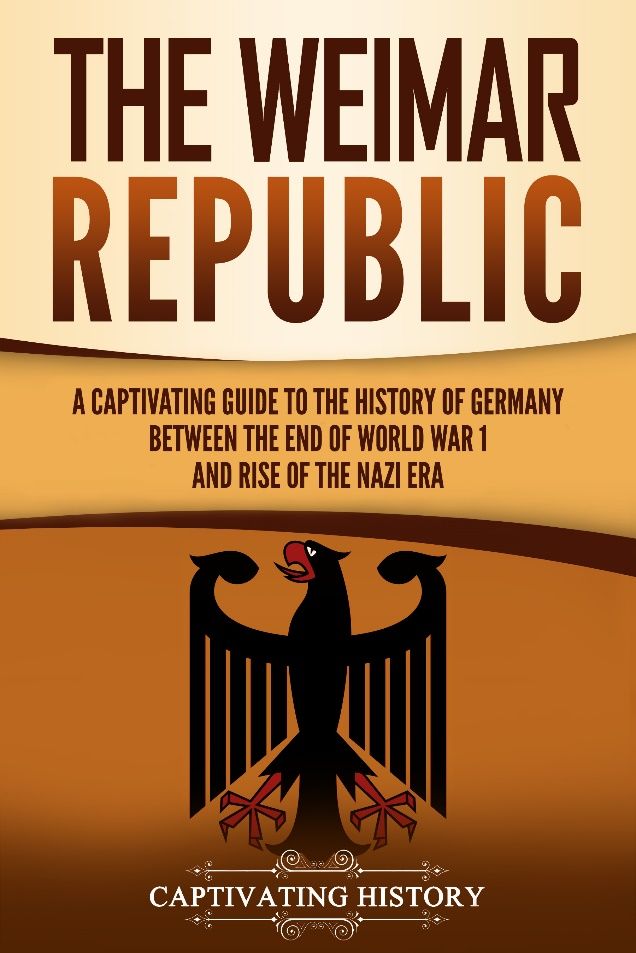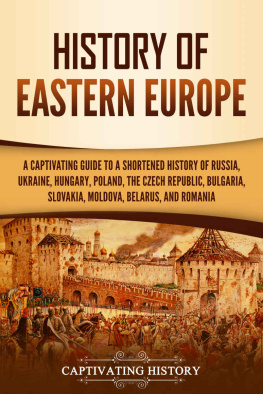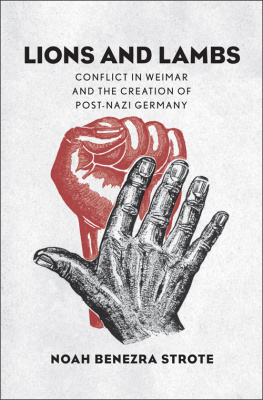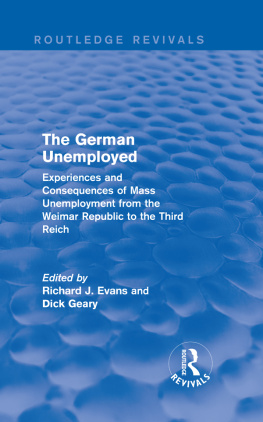Weimar Republic
A Captivating Guide to German History between 1919 to 1933 and the Treaty of Versailles
Copyright 2021
All Rights Reserved. No part of this book may be reproduced in any form without permission in writing from the author. Reviewers may quote brief passages in reviews.
Disclaimer: No part of this publication may be reproduced or transmitted in any form or by any means, mechanical or electronic, including photocopying or recording, or by any information storage and retrieval system, or transmitted by email without permission in writing from the publisher.
While all attempts have been made to verify the information provided in this publication, neither the author nor the publisher assumes any responsibility for errors, omissions or contrary interpretations of the subject matter herein.
This book is for entertainment purposes only. The views expressed are those of the author alone, and should not be taken as expert instruction or commands. The reader is responsible for his or her own actions.
Adherence to all applicable laws and regulations, including international, federal, state and local laws governing professional licensing, business practices, advertising and all other aspects of doing business in the US, Canada, UK or any other jurisdiction is the sole responsibility of the purchaser or reader.
Neither the author nor the publisher assumes any responsibility or liability whatsoever on the behalf of the purchaser or reader of these materials. Any perceived slight of any individual or organization is purely unintentional.
Free Bonus from Captivating History: History Ebook
Hi History Lovers!
My name is Matt Clayton, and Im the creator of Captivating History. First off, I want to THANK YOU for reading our books in the Captivating History series. As an avid reader of History myself, I aim to produce books that will hold you captive.
Now you have a chance to join our exclusive history list so you can get the ebook below for free as well as discounts and a potential to get more history books for free! Simply click the link below to join.
P.S. If you join now, you will also receive a free Mythology book. Remember that its 100% free to join the list.

Click here to access your bonus
Also, make sure to follow us on:
Twitter: @Captivhistory
Facebook: Captivating History: @captivatinghistory
Youtube: Captivating History
Table of Contents
Part 1: The Weimar Republic
A Captivating Guide to the History of Germany Between the End of World War I and Rise of the Nazi Era

Introduction
Although Adolf Hitler is one of the most notorious and well-known characters in modern history, few people know that his rise to iron-fisted dictatorship actually began in the waning days of the democratic Weimar Republic.
Born from the ruins of World War I, this little-known republic could be thought of as less than a geographical place and more of an era for a well-known countryGermany. The Weimar Republic, Germanys first democratic government, was named after its birthplace, the German city of Weimar.
Though only in existence for a brief fourteen years, a virtual blip in history, its story is fascinating and important. With nearly half the men in the country fighting an unwinnable war in 1918, Germany was on the brink of starvation, economic collapse, and mutiny. Those who survived the 1916/17 winter, which they called the Turnip Winter, a bitter name given from the indignity of having to eat food they saw fit only for cattle, could hardly dream of having meat to eat. Hunger riots rocked the streets of Berlin, and workers went on strike, as they were fed up with unlivable wages and poor working conditions. Inspired by the recent Russian Revolution, talk of revolt permeated the air.
Faced with problems on every front, Germany had some difficult decisions. Disenchanted with the monarchy of Kaiser Wilhelm II and seeking to appease the Allied nations, their answer was the Weimar Republic. Understanding the mutinous events that led up to its existence, how it was instituted to fix a desperate situation within the country, and the reasons it failed gives us insight into how Germany gave rise to one of the most infamous dictators in all of history.
Weimars history also shows how Allied countries that were reeling from the brutality of World War I and their attempts to console themselves with reparations and a treaty actually helped lay the groundwork for World War II.
Chapter 1 The Kiel Mutiny
The officers knew it was a suicide mission. In fact, the night before, many of them partied and drank, toasting the death ride of the German navy. Negotiations for an armistice with the Allies had been underway for the last few weeks, but none of the eighty thousand sailors assigned to be involved with the unsanctioned Operation Plan #19 was seeking the infamy of being sacrificed in an apocalyptic last-ditch sea battle effort.
Imperial Naval Commander Admiral Franz von Hipper had become impatient with the restructuring of the government and efforts at peace being undertaken by Kaiser Wilhelm II. Hoping that a show of movement toward democracy would appease the Allies during the peace negotiations, the Kaiser appointed Prince Maximilian von Baden as the new chancellor at the beginning of October 1918. He was backed by a cabinet of Social Democrats.
Von Hipper knew that his audacious last battle plan would be put down if he presented it to von Baden. So, he decided he wouldnt present it and would just go ahead without permission. Perhaps seeking a last shot at glory or to save the honor of the fleet, von Hipper went ahead with his naval order, giving it twenty days later on October 24th.
War-weary sailors were already long discontented with the conditions imposed upon them on their ships. Their food rations were not only inadequate, but they were also of poor quality and utterly monotonous. To add insult to injury, the sailors watched as officers enjoyed delicious feasts at banquets while they languished in their separated cramped quarters. Officers enjoyed relative comfort aboard the battleships and dreadnaughts. The physical separation from the officers gave the sailors a sense of growing isolation, and it made it seem as if the officers were indifferent to their suffering. It created fertile ground for complaints to be aired among the groups of disgruntled men bunking together.
The constant discussion of grievances caused the men to reach a boiling point, and the talk was sure to eventually give way to action. Many of their fellow soldiers had already deserted, having escaped into German port towns and disguising themselves as citizens. What actions could those still aboard the ships take?
Now the men who had stayed in their assignments were asked to sacrifice again for their final daring mission of the war. The German fleet was planning coordinated attacks against the Allied forces at the mouth of the Thames and in the English Channel near northern France. Of course, the sailors were no cowards; they were willing to fight if attacked first. But to go into battle unprovoked was another story. What would it accomplish if Germany was about to agree to the armistice with the Allies anyway? Did they really want to take part in an action that might derail peace negotiations with the Allied forces? It was no surprise that a mutiny was brewing.
At the end of October 1918, the first mutinous crews finally broke. Germanys fleet was docked just north of the town of Wilhelmshaven, waiting to leave for battle. The rumblings of rebellion began on October 28th, with crews aboard numerous ships defying orders from their commanders. It wasnt long before the situation escalated.















